Huihui Zhu
Towards Quantum Federated Learning
Jun 16, 2023Abstract:Quantum Federated Learning (QFL) is an emerging interdisciplinary field that merges the principles of Quantum Computing (QC) and Federated Learning (FL), with the goal of leveraging quantum technologies to enhance privacy, security, and efficiency in the learning process. Currently, there is no comprehensive survey for this interdisciplinary field. This review offers a thorough, holistic examination of QFL. We aim to provide a comprehensive understanding of the principles, techniques, and emerging applications of QFL. We discuss the current state of research in this rapidly evolving field, identify challenges and opportunities associated with integrating these technologies, and outline future directions and open research questions. We propose a unique taxonomy of QFL techniques, categorized according to their characteristics and the quantum techniques employed. As the field of QFL continues to progress, we can anticipate further breakthroughs and applications across various industries, driving innovation and addressing challenges related to data privacy, security, and resource optimization. This review serves as a first-of-its-kind comprehensive guide for researchers and practitioners interested in understanding and advancing the field of QFL.
HRDoc: Dataset and Baseline Method Toward Hierarchical Reconstruction of Document Structures
Mar 24, 2023



Abstract:The problem of document structure reconstruction refers to converting digital or scanned documents into corresponding semantic structures. Most existing works mainly focus on splitting the boundary of each element in a single document page, neglecting the reconstruction of semantic structure in multi-page documents. This paper introduces hierarchical reconstruction of document structures as a novel task suitable for NLP and CV fields. To better evaluate the system performance on the new task, we built a large-scale dataset named HRDoc, which consists of 2,500 multi-page documents with nearly 2 million semantic units. Every document in HRDoc has line-level annotations including categories and relations obtained from rule-based extractors and human annotators. Moreover, we proposed an encoder-decoder-based hierarchical document structure parsing system (DSPS) to tackle this problem. By adopting a multi-modal bidirectional encoder and a structure-aware GRU decoder with soft-mask operation, the DSPS model surpass the baseline method by a large margin. All scripts and datasets will be made publicly available at https://github.com/jfma-USTC/HRDoc.
SEMv2: Table Separation Line Detection Based on Conditional Convolution
Mar 08, 2023Abstract:Table structure recognition is an indispensable element for enabling machines to comprehend tables. Its primary purpose is to identify the internal structure of a table. Nevertheless, due to the complexity and diversity of their structure and style, it is highly challenging to parse the tabular data into a structured format that machines can comprehend. In this work, we adhere to the principle of the split-and-merge based methods and propose an accurate table structure recognizer, termed SEMv2 (SEM: Split, Embed and Merge). Unlike the previous works in the ``split'' stage, we aim to address the table separation line instance-level discrimination problem and introduce a table separation line detection strategy based on conditional convolution. Specifically, we design the ``split'' in a top-down manner that detects the table separation line instance first and then dynamically predicts the table separation line mask for each instance. The final table separation line shape can be accurately obtained by processing the table separation line mask in a row-wise/column-wise manner. To comprehensively evaluate the SEMv2, we also present a more challenging dataset for table structure recognition, dubbed iFLYTAB, which encompasses multiple style tables in various scenarios such as photos, scanned documents, etc. Extensive experiments on publicly available datasets (e.g. SciTSR, PubTabNet and iFLYTAB) demonstrate the efficacy of our proposed approach. The code and iFLYTAB dataset will be made publicly available upon acceptance of this paper.
Abnormal Behavior Detection Based on Target Analysis
Jul 29, 2021



Abstract:Abnormal behavior detection in surveillance video is a pivotal part of the intelligent city. Most existing methods only consider how to detect anomalies, with less considering to explain the reason of the anomalies. We investigate an orthogonal perspective based on the reason of these abnormal behaviors. To this end, we propose a multivariate fusion method that analyzes each target through three branches: object, action and motion. The object branch focuses on the appearance information, the motion branch focuses on the distribution of the motion features, and the action branch focuses on the action category of the target. The information that these branches focus on is different, and they can complement each other and jointly detect abnormal behavior. The final abnormal score can then be obtained by combining the abnormal scores of the three branches.
A Large Scale Urban Surveillance Video Dataset for Multiple-Object Tracking and Behavior Analysis
Apr 26, 2019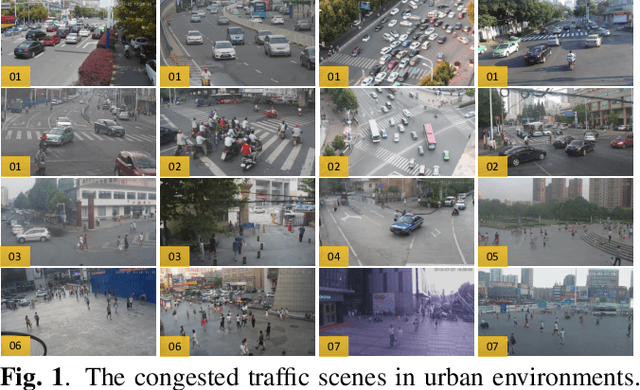


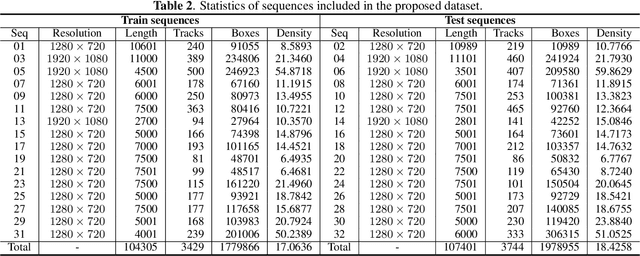
Abstract:Multiple-object tracking and behavior analysis have been the essential parts of surveillance video analysis for public security and urban management. With billions of surveillance video captured all over the world, multiple-object tracking and behavior analysis by manual labor are cumbersome and cost expensive. Due to the rapid development of deep learning algorithms in recent years, automatic object tracking and behavior analysis put forward an urgent demand on a large scale well-annotated surveillance video dataset that can reflect the diverse, congested, and complicated scenarios in real applications. This paper introduces an urban surveillance video dataset (USVD) which is by far the largest and most comprehensive. The dataset consists of 16 scenes captured in 7 typical outdoor scenarios: street, crossroads, hospital entrance, school gate, park, pedestrian mall, and public square. Over 200k video frames are annotated carefully, resulting in more than 3:7 million object bounding boxes and about 7:1 thousand trajectories. We further use this dataset to evaluate the performance of typical algorithms for multiple-object tracking and anomaly behavior analysis and explore the robustness of these methods in urban congested scenarios.
Real-Time Anomaly Detection With HMOF Feature
Dec 12, 2018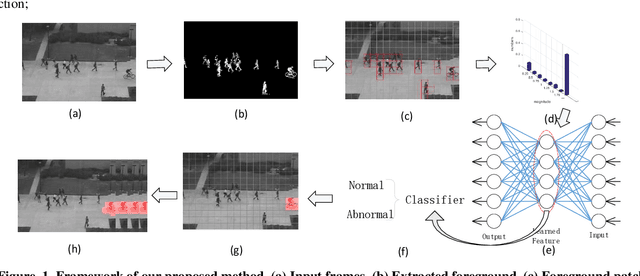
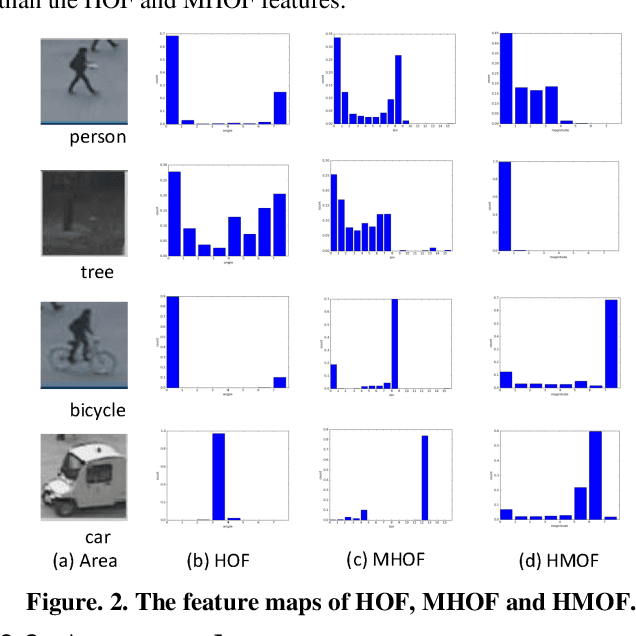
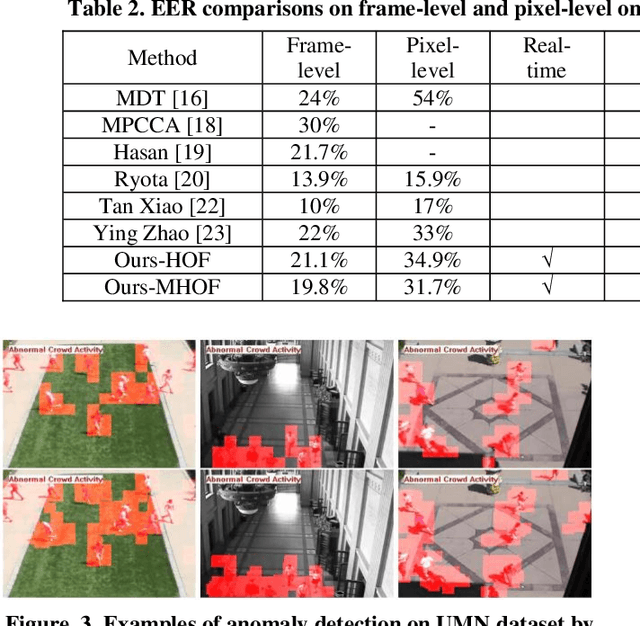
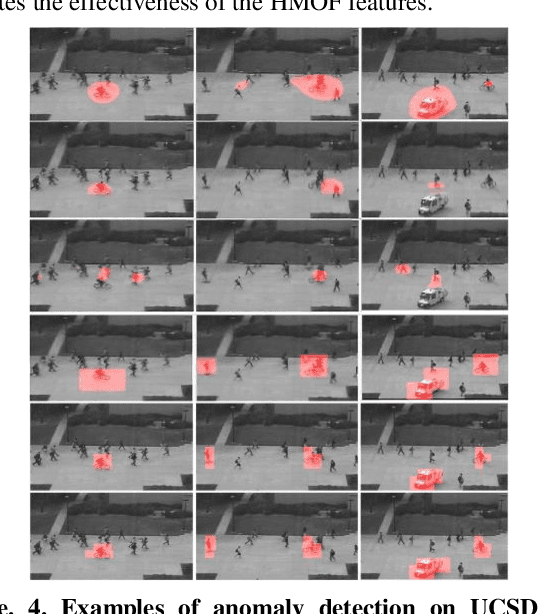
Abstract:Anomaly detection is a challenging problem in intelligent video surveillance. Most existing methods are computation consuming, which cannot satisfy the real-time requirement. In this paper, we propose a real-time anomaly detection framework with low computational complexity and high efficiency. A new feature, named Histogram of Magnitude Optical Flow (HMOF), is proposed to capture the motion of video patches. Compared with existing feature descriptors, HMOF is more sensitive to motion magnitude and more efficient to distinguish anomaly information. The HMOF features are computed for foreground patches, and are reconstructed by the auto-encoder for better clustering. Then, we use Gaussian Mixture Model (GMM) Classifiers to distinguish anomalies from normal activities in videos. Experimental results show that our framework outperforms state-of-the-art methods, and can reliably detect anomalies in real-time.
 Add to Chrome
Add to Chrome Add to Firefox
Add to Firefox Add to Edge
Add to Edge